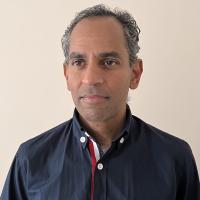Why should rheumatologists discuss exercise in PMR? Save

My colleague says, “I simply refer to physiotherapy. I don’t have time to discuss exercises, we need that time to discuss medications, side-effects, etc.” I sympathise; we could not answer all the questions that will follow the exercise-promotion spiel, such as who needs exercises, when, where, how and what. Versus Arthritis booklet on Polymyalgia Rheumatica mentions range of motion exercises for stiffness and weight-bearing exercises for bone health. What about muscle strength? What is essential, aerobic or resistance? Dumb bells and quads or planks and wall sits? Vibration plates or star jumps?
I am lost. Rheumatologists had our ‘Rehabilitation’ gene snipped out long before CRISPR.
I had been doing telephone consults for an 80-year-old man with PMR who has not left his apartment since the pandemic, as he was too weak to leave his bed. He started prednisolone 5 years ago; and never managed to get below 5mg daily due to pain and myalgia in the mornings. His daughter gave up work to care for him. We got some blood tests taken at home. Despite a normal ESR and CRP, I increased his Prednisolone to 10mg. It helped his pain; he can walk to the kitchen & toilet. However, still could not leave his apartment. He does not want physiotherapy although he agreed for a single home visit to assess for falls.
We are glad for any advice from physiotherapy, as I could not refer to many providers outside my district. Often, I dig out a 2009 DVD on self-management produced by PMR-GCA-UK North East support group. The physiotherapist in the video explains the benefits of exercises in polymyalgia rheumatica or giant cell arteritis. She had three key messages; firstly, avoidance of physical activity due to pain and stiffness from PMR deconditions skeletal muscles. This causes more fatigue and weakness, which will improve with prednisolone and resuming normal physical activity. Secondly, long-term or high dose steroids cause arm or leg weakness and this needs physiotherapy. Thirdly, rest when there is a flare of PMR, start slow and build up activity.
Much of the above advice is still correct, but an update is sorely needed, as our knowledge of muscle weakness in PMR has changed in the 15 years since that DVD was produced. Therefore, I muscled into the PMR-GCA-UK patient conference to say that we need to design a new exercise program. A meeting to brainstorm rehabilitation for musculoskeletal deconditioning by the great minds in PMR, physiotherapy and ageing concluded that we need to prevent both osteosarcopenia of ageing and muscle weakness of PMR. All we need is somebody interested, ideally a physiotherapist – student, clinical or academic, to apply his or her mind & muscle to this research for the next 3 years!
Our superior belief in scans and biologics has meant that we no longer have enough physiotherapists integrated into rheumatology multi-disciplinary teams. Specialist Physiotherapists are now Advanced Practitioners doing a physician’s role with less time to provide therapy. Our hospitals have lost essential physiotherapy infrastructure such as gyms and hydrotherapy pools, as we believed that these could be done in the community. After the pandemic, communities across the UK have also been ‘active’ in closing their gyms and swimming pools, as we could not afford them. So patients are on their own, trying to get advice on ‘exercises at home, by post, telephone or video’.
Not all is lost. We understand muscle metabolism better: resistance training, higher protein intake, reducing inflammation & insulin resistance are all needed to prevent osteosarcopenia. Our patients follow social media more than us; they are more likely to be listening to exercise evangelists like Drs Gabrielle Lyons and Peter Attia than our physiotherapists. Some may even follow the longevity lord Dr David Sinclair of Harvard. Can his hacks really reverse the years of ageing caused by chronic illnesses like PMR?
Patients with PMR under care of rheumatologists include those with GCA and more likely to suffer muscle weakness than patients with PMR who have been successfully managed by family practitioners. Atypical presentations of PMR is also higher among our cohort, because of difficulties in diagnosis and weaning off. Some simply have a steroid-responsive pain condition, not necessarily PMR. The cumulative dose of steroids is often higher. Whilst DMARDs such as Methotrexate & recently Tocilizumab in GCA and Sarilumab in PMR, can help keep the steroid dose low, this is no guarantee of reversing muscle loss from multiple factors that feed each other.
How to promote activity and muscle strength among our patients? We could start with our own habits in clinic. It is tempting to read the charts a bit longer and let our nurses collect patients from the waiting room. Walking the patient ourselves helps our step count and we can observe our patient’s mobility, how they sit down and get up. Try using the Glucocorticoid Toxicity Index (GTI) in clinic. The myopathy component is simple – assessing only the deltoid and quadriceps on a 3-point scale – minor, moderate and major.
Rheumatologists need to promote exercises. We must join our local physiotherapists to study what they do and invest in them. They can be more effective than cost-a-lot-umabs.
Acknowledgments - I thank Dr Sarah Fargaly, Specialty Doctor in Rheumatology and General Medicine, Gateshead for her feedback on the earlier version of this blog.This blog is a reflection from North East of England Rheumatology conference on ‘Rehabilitating Musculoskeletal Deconditioning’ on 16th May 2023. I am grateful to Dr Sarah Mackie, Associate Professor in Vascular Rheumatology, University of Leeds, Dr Thurkka Rajeswaran, Rheumatology registrar at Leeds, Mrs Emily Deeney, Rheumatology Physiotherapist at Gateshead, Ms Gemma O’Callaghan, Rheumatology Occupational Therapist at Freeman Hospital, Professor Clinton Rubin, Director of Musculo-Skeletal Research Laboratory and Center for Biotechnology at State University of New York, Dr Christopher Hurst, Sports and Exercise scientist at the AGE Research Group, Newcastle University and Dr Joshua Bennett, Paediatric rheumatology registrar and PhD student at Newcastle for their contribution to the conference.








If you are a health practitioner, you may Login/Register to comment.
Due to the nature of these comment forums, only health practitioners are allowed to comment at this time.